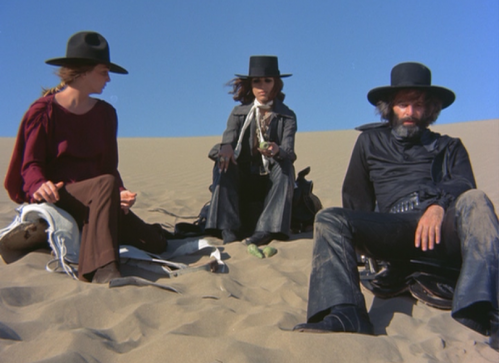Imagine Luis Bunuel, Quentin Tarantino, and Gabriel Garcia Marquez rolled into one and you'd probably get Alejandro Jodorowsky. He has called himself the "father of the midnight movie" and he's probably right. Throughout his career Jodorowsky has provoked, outraged, offended, and disrupted at least as many people as Mssrs. Bunuel, Tarantino, and Marquez. Mainstream cinema (read: Hollywood's studios) effectively ignored him, dangling a possible production of Dune based on the novel by Frank Herbert in front of him, then abruptly taking it away.
Watching a Jodorowsky film is an unnerving experience; you want to look away but you can't. You don't know why you can't stop watching what is unfolding from moment to moment. Is it because the imagery is so shocking? Because it is beautiful one instant and repulsive the next? Peaceful, then violent? Jodorowsky has called his worldview many things, but the one that sticks with me the most is psychoshamanism. It's perfect and describes his art beautifully. There's always a deep religious, spiritual component combined with matters of the self and the compassion or brutality that people exhibit towards each other. Families gone horribly wrong, people on personal quests, violence as a means of cleansing, absurdist, comic moments, the list seems about as varied as the human condition.
Jodorowsky came to film from the theater and pantomime and in El Topo, released in 1970 (he's the lead) you'll see how his years touring (and writing sketches) with Marcel Marceau's troupe informs his acting style. But this isn't a mime you poke fun at for being a mime. It's a terrific, cinematic, horrifying, exhilarating, and life affirming tour de force bit of acting. Still, the movie's (as with all of his movies) greatest strength lies in Jodorowsky's inventive, provocative, political, allegorical, and poetic imagery. It's as if Heironymous Bosch, Todd Browning, and Fellini had somehow managed to live and work in South America!
 |
| Santa Sangre (1989). The elephant's funeral march. What can one say about these images? They speak for themselves. Fellini was surely a fan. |
Jodorowsky's scenes are often living tableaux. Dali's surrealism comes to mind. The images and actions are disturbing but not in an exploitative way. Fascinating to watch how carefully, how meticulously his set pieces unfold, each new development symbolizing something, moving towards some inexorable, inevitable ending. It usually goes one of two possible ways: humanity is a brutal, soulless, barbaric thing or it is compassionate and caring. Regardless, there is always mortality, finality, the transience of life, and its opposite, eternity, immortality, and maybe even the divine.
Try synopsizing a Jodorowsky film. Impossible. Too much happens. Too many turns, leaps in time, transformations, magical or hyper-real events. Here's the Netflix summary for Santa Sangre:
When a woman catches her husband philandering with another woman, she pours acid on him, after which he chops off her arms and kills himself. Now, she exists as a vengeful circus performer. The situation leaves their son, Fenix, severely disturbed.
 |
| The iguana circus act from Santa Sangre (1989). Easily one of the most surreal moments in the history of cinema. |
Here's Netflix's summary of El Topo:
In this surreal Western, avant-garde filmmaker Alejandro Jodorowsky uses allegory and religious iconography to tell the story of a gunfighter, El Topo (Jodorowsky), who wanders the desert on an odyssey seeking enlightenment. But first, he must defeat four master gunfighters and dig a tunnel to free a colony of deformed underground dwellers from their dark confines. This experimental film reached cult status as the first of the "midnight movies."
Chilean avant-garde filmmaker Alejandro Jodorowsky weaves a grotesque tale rich in allegory and sacrilegious imagery as a thief (Horácio Salinas) is first crucified, then enlisted by an alchemist (Jodorowsky) to join a group of elites who seek divinity and immortality. Juan Ferrara, Adriana Page, Richard Rutowski, Valerie Jodorowsky, Zamira Saunders and Ana De Sade also star in this surreal 1970's mind trip.
OK! I'll take it. But it doesn't even come close. Jodorowsky's re-vamping of the Tarot for Holy Mountain, his enlisting of actors willing to take hallucinogenics with him - while being filmed - his choice to film the story in chronological order - his meta-ending wherein he pulls back the curtain to remind us this quest for divinity is nothing more than a movie...it all defies categorization. Iconoclastic, avant-garde, meh...I would say supremely humanist.
A personal note: I arrive late to this party. Raised on mainstream Hollywood fare (old and new) and foreign (mostly European and Asian) cinema, Latin American cinema had always been a bit of a non-starter for me. Moreover, seeing the ads for El Topo back in the 80's was a turn off. Why see a low budget cult film? I genuinely believed Jodorowsky's films were made on shoestring budgets and told incoherent stories relevant only to the filmmaker and his coterie of followers. Boy, was I wrong. Jodorowsky's budgets, while they are a fraction of the amount spent on even a small US film, packed a huge economic wallop in South America. His films have dozens - if not hundreds - of extras, major set pieces, virtuosic camera work, and first rate overall production values. See a Jodorowsky film. They're unforgettable and no one walks away indifferent to them.
 |
| Alejandro Jodorowsky. Poet, mime, painter of images, explorer of the human soul. |








Comments
Post a Comment